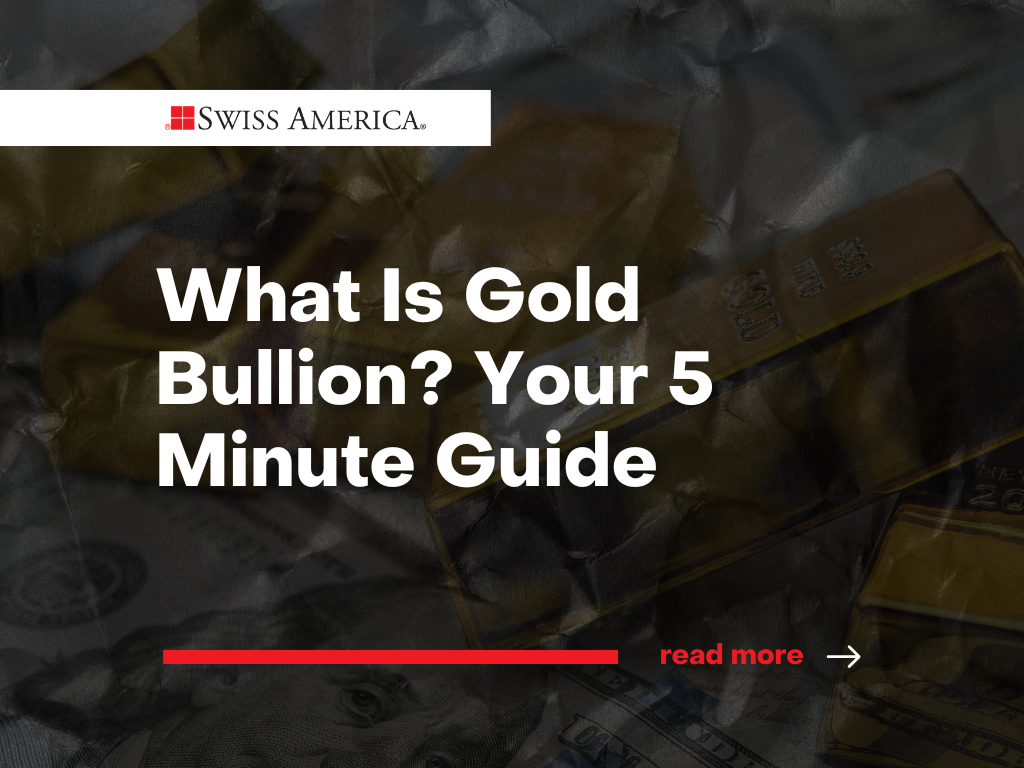
What is gold bullion? It’s physical gold in bars or coins that investors use to diversify their portfolios. In this guide, you’ll discover how to buy gold bullion, what investment options you have, and learn if alternatives like silver might suit your financial goals.
The price of gold increased by 5% in 2023 and is now up over 30% this year, reaching $2700 per ounce as of this writing. Economic uncertainty, concerns over national debt, and wars across the world cause people to want tangible investments like gold. If that’s you and you are wondering why the industry uses the term gold bullion and what it really means, we’ll cover that in this article.
You’ll also learn how you can buy gold, what your options are, and how to choose the right gold dealer to work with.
What is gold bullion?
Gold bullion refers to physical gold with a high purity of 99.5% to 99.99%. The London Bullion Market Association (LBMA) sets these standards, requiring a minimum purity of 99.5%, to maintain the quality and value of the gold market. You can buy this tangible asset as bars or coins, with most consumer gold refined to a purity of 99.99%.
Gold bullion history
Historians believe the term “bullion” originated from Claude de Bullion, a 17th-century French Minister of Finance under Louis XIII, who was instrumental in establishing gold’s significance as a financial tool during his time.
Gold standard
Gold has always been a store of value, cherished for its rarity and resistance to corrosion. For centuries, gold linked directly to currency, serving as the foundation for the global monetary system. This gold standard allowed countries to back their paper currency with a fixed quantity of gold, providing stability and trust in economic exchanges.
The United States adopted the gold standard in 1834 and abandoned it in 1971 under President Nixon.
Fiat currency
Today, countries operate under a fiat currency system where money isn’t tied to a physical commodity. This means greater flexibility in monetary policy but also exposes economies to inflation and currency devaluation.
This separation from gold is one of the key reasons why investors continue to hold gold, since it is completely independent of paper currency and economic swings.
Types of gold bullion products
You can buy gold bullion as coins or bars:
Gold bullion coins
Governments mint gold bullion coins, which have legal tender status. The face value of these coins is usually lower than the actual gold they contain. Their worth comes from the precious metal content, rarity, design, and historical significance.
Bullion coins vs proof coins
Bullion coins get their name from the “bullion finish” used in their minting process. This low-cost production method makes them affordable for investors seeking lower-premium coins.
“Proof coins” have a more costly production process which creates a combination of polished and matte finishes. These coins have a higher value because of this manufacturing process and limited production.
Legal tender
Most gold bullion coins hold legal tender status, with a small face value assigned by the issuing government. Their true value is much higher, based on the precious metal content and market demand. Legal tender status adds an extra layer of security for investors since it guarantees the coin’s weight, purity, and authenticity by the issuing government.
Common bullion coins
- American Gold Eagle
- Canadian Gold Maple Leaf
- South African Krugerrand
- Australian Gold Kangaroo
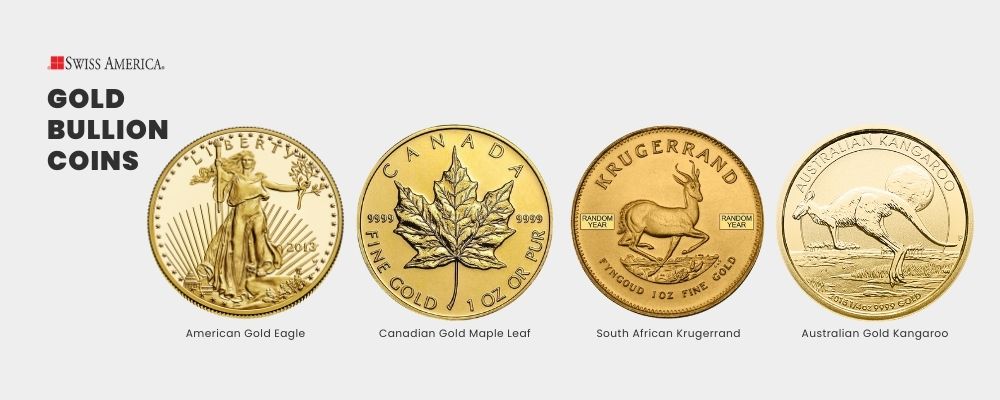
Gold bullion bars
Gold bullion bars, also called ingots, come as rectangular slabs of gold in various weights, from 1 gram to 400-ounces. Manufacturers stamp each bar with its weight, purity, and a unique serial number for identification. Central banks or institutional investors buy these bars in the larger sizes like 10 ounces and above.
Minted vs cast bars
You can buy two different kinds of gold bullion bars:
Minted bars
Manufacturers cut these from a sheet of rolled gold. A die punches the sheet into blanks of a certain size and weight. They then go through a minting press to create the design and information like the denomination, year of minting, weight, purity, and the country of origin.
These bars come sealed in a protective plastic case that includes the serial number and assayer details.
Cast bars
Manufacturers make them by pouring molten gold into bar-shaped molds and cooling them until they solidify. This creates a rustic finish with rounder edges than minted bars. Manufacturers print the solid bars with their name, weight, purity, and individual serial number.
Cast bars aren’t laminated but they come with a separate paper certification.
Gold coins vs bars
If you’re trying to decide between coins or bars, there’s a case to be made for either depending on your goals and how much you plan to invest.
Premiums: The premium over spot price is higher with coins than bars. This is because bars have lower manufacturing costs. Coins are more intricate and also have collectible value which contributes to their cost.
Portability: Coins are smaller and easier to take with you. Plus, they have global recognition which makes them easy to sell if needed.
Value: Coins can have numismatic value which basically means they are worth more due to rarity or historical significance. Newer investors who worry about scams might like bars better since they have serial numbers and certificates that verify authenticity.
Differences between gold and silver bullion
If you are getting started in precious metals, you may wonder if you should invest in silver instead of gold. Both are excellent investments but for different reasons.
Market size and liquidity: Gold has a larger market and is more liquid than silver, so it’s easier to buy and sell without affecting the price. Silver’s smaller market size can lead to greater price volatility.
Industrial demand: Silver’s use in industries like electronics and solar panels makes its price more volatile. Meanwhile, gold demand mostly comes from its use as a financial asset and store of value.
Cost and accessibility: Silver bullion bars cost less per ounce than gold, making it accessible to smaller investors. Right now, the gold to silver ratio is about 80% meaning gold costs about 80% more.
The decision between gold and silver bullion depends on your risk tolerance and investment strategy. Many investors decide to add both to their portfolios to give them stability and growth potential.
Why invest in gold?
Experts often recommend keeping a percentage of your assets in gold because it helps you:
Diversify
Holding physical gold bullion is a great way to diversify your savings. As we mentioned above, gold isn’t tied to currency so if something happens to paper money, your gold can still hold value. It also moves independently of stocks.
This gives you a way to balance your portfolio and reduces the risk you’ll lose everything if the market crashes or currency devaluation. Gold also performs well over the long-term compared to other asset classes:
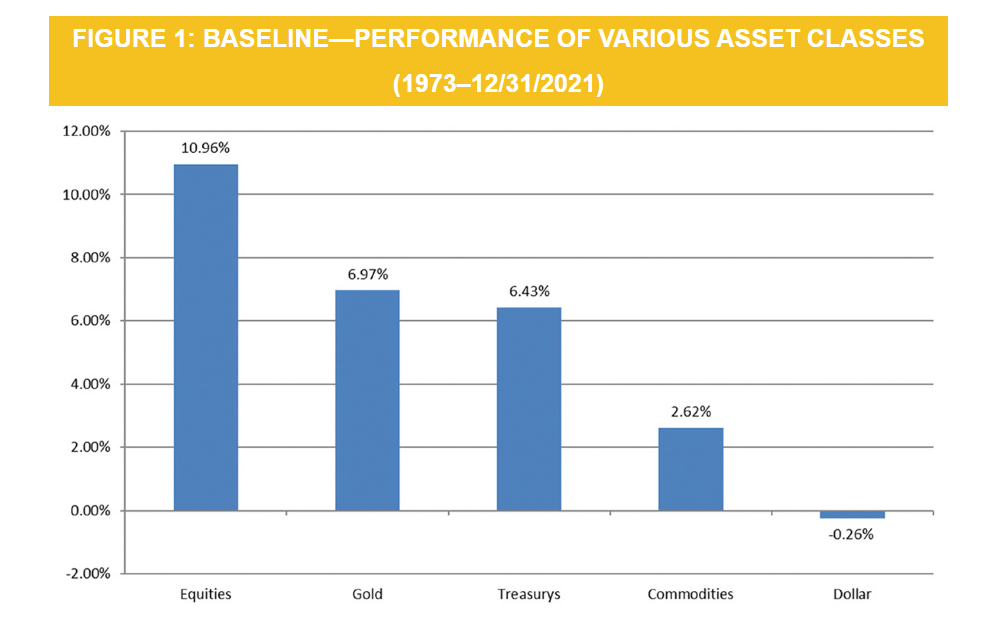
Protect wealth
People have leveraged gold and other precious metals as a way to preserve wealth for centuries. When inflation spikes, gold prices often rise even more, making it a reliable hedge. Looking back, the World Gold Council found that gold returned about 15% per year when inflation was above 3%, and just 6% during lower inflation periods.
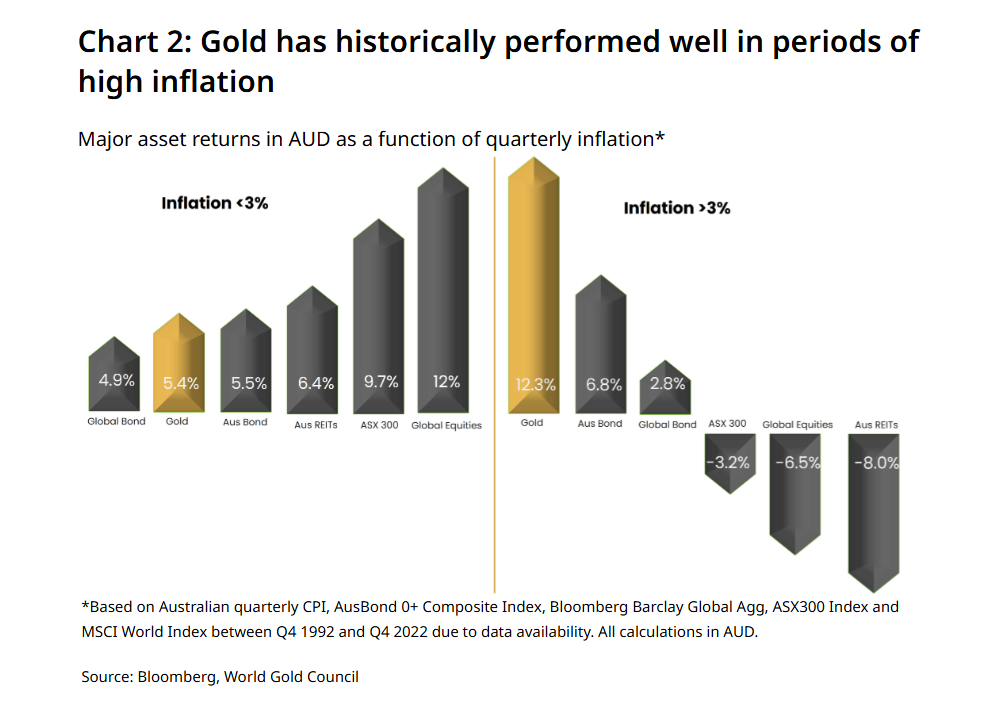
Hedge against uncertainty
During chaos and uncertainty like political turmoil, economic downturns, or financial crises, investors turn to gold. This is because it doesn’t rely on any company or industry or the stability of any one government.
How the gold bullion market works
The market for gold includes a global network where central banks, institutional investors, mining firms, and private investors buy and sell gold. All of these players shape the market dynamics and influence the gold price.
Market structure
The gold bullion market operates 24 hours a day with constant trading across different time zones. Transactions mainly happen via over-the-counter (OTC) or on exchanges like the London Bullion Market Association.
World Gold Council’s recent trading data shows the volume by market:

Key participants
Central banks hold gold as a reserve asset to hedge against economic instability and also to reduce reliance on the U.S. dollar. Investors use it for insurance and as a way to reduce risk. Most trading happens on the “spot market” for immediate delivery at the current price.
There are also paper gold and futures contracts for speculating on prices without owning the metal, though these carry additional risks.
World Gold Council reports that in 2024, central banks bought record amounts of gold for their reserves.
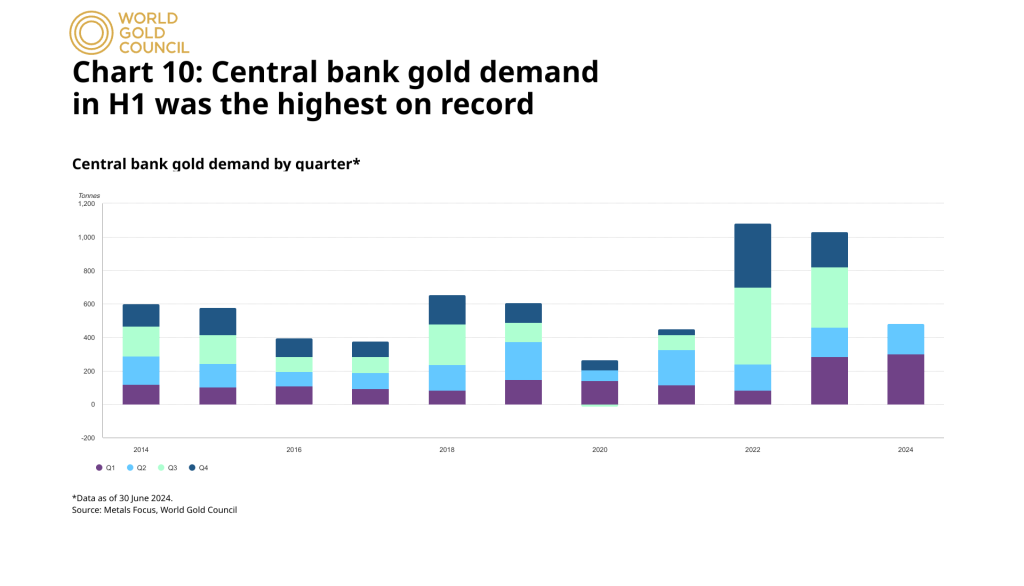
Pricing and valuation
The market quotes gold prices in troy ounces, and its fine gold content determines the value of bullion. The purchase price includes a premium over the spot price to cover costs like manufacturing and transport. You’ll often find that larger bars have lower premiums.
Selling prices are usually a bit lower than the spot price since sellers compete to sell their gold.
Market influences
Gold prices change based on:
Interest rates: When interest rates are low, investors buy more gold because other “safe havens” like savings accounts, have lower returns.
Wars: Gold prices go up in times of conflict or political unrest. This is because investors want the security of a tangible asset.
Currency changes: Since people buy gold at U.S. dollar prices, changes in the dollar’s value affect its price. When the dollar has lower value, foreign investors buy more gold.
Supply: There’s only so much gold on the earth but mining companies can impact gold prices depending on their production levels.
How to buy gold bullion
If you want to add gold to your investment portfolio, here’s a few options:
Direct purchase: The most straightforward investment method is buying physical gold bullion bars or coins from a trusted source. You can store and insure the gold yourself or through a third-party service.
Gold IRAs: A Gold IRA allows you to hold physical gold within a tax-advantaged retirement account. This option is great for diversifying your retirement portfolio with a solid, stable asset. With an IRA, you’ll use a custodian to manage your gold, which means they’ll buy and sell it on your behalf and handle secure storage.
ETFs and mutual funds: These offer exposure to gold prices but they are paper assets versus owning physical gold.
Futures contracts: For the more speculative investor, futures contracts allow you to bet on future gold prices.
Gold bullion tips
Here is some additional information you’ll want to know about buying gold bullion.
Buying details: If you decide to buy gold or other precious metals, ask about purity and weight. Compare the gold spot price and check for hidden fees. Look for marks like “999.9” and weight indicators such as “1 oz” on a gold bar.
Find a reputable dealer: Buy from an established dealer like Swiss America with a strong reputation and industry certification. Ask for Certificates of Authenticity (COA) and verify that they match the bullion’s weight, purity, and serial number.
Storage options: Plan for secure storage to protect your investment like home safes, bank vaults, and third-party storage facilities.
Selling considerations: Work with trusted dealers like Swiss America that have a buy-back program that makes it easy to sell when you are ready.
Why buy gold bullion from Swiss America
When you’re ready to add gold to your investment portfolio, consider why so many investors trust Swiss America. With over 40 years of experience, we’ve supported investors through different economic cycles, making us a reliable partner in the precious metals market.
Our happy customers value our timely delivery, knowledgeable customer service, and consistent quality. We offer expert guidance on storage options, precious metals IRAs, and portfolio strategies, ensuring you get the information you need.
You’ll also get transparent pricing, plus our gold trade program provides liquidity when you need it, making selling back easy for emergencies or portfolio adjustments.
Bullion definition final thoughts
People turn to gold as a reliable and tangible way to guard against the world’s risks.
Gold bullion offers a time-tested method to diversify your portfolio and protect your wealth. As you consider investing, choose reputable dealers, decide on the different forms of gold bullion and your investment vehicle options.
To learn more, contact our team today to learn how to add this valuable asset to your investment strategy.
What is gold bullion? FAQs
What’s the difference between gold and gold bullion?
Gold refers to metal in general, while the term gold bullion means high-purity gold in physical forms like bars and coins.
What is meant by gold bullion?
Gold bullion is physical gold that’s usually 99.5% or higher in purity. It comes in coins or bars.
Why is it illegal to own gold bullion?
No, owning gold bullion is not illegal in most countries today. In the past, some governments restricted gold ownership in the past to control economic conditions, like the U.S. did in 1933 during the Great Depression.
Note: The information in this post is for informational purposes only and should not be considered tax or legal advice. Please consult with your own tax professionals before making any decisions or taking action based on this information.
